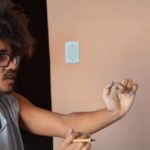
- Home
- Who we are
- Initiatives
- 2023
- 2022
- 2021
- 2020
- 2019
- Acreditar
- Capão’s Citizen Association
- CENEP
- ClareArt Association
- Dreaming Project Institute
- Interference
- Nursery Walk With Love is the Solution
- Organic Outskirts
- Panthers’ Productions Collective
- Sementinha Project (Little Seed) – Year 5
- Stitch to Stitch Collective
- The Story Finders Collective
- Untangle and Don’t Fool Me Collective
- 2018
- 2017
- 2016
- 2015
- 2014
- Partners
- Network and Territory
- Transparency
- Publications
- Make a donation!
Panthers’ Productions Collective
2019The Initiative
Who We Are
The Panthers’ Productions Collective (Coletivo Panteras Produções) started from a 6ª class of News School – a social initiative of Campo Limpo neighborhood that aims to insert youth in the job market, more specifically in the communications branch, by making use of information technologies – which a percentage of the participants had attended workshops that dealt with the subjects, such as journalism and audiovisual.
Feeling the need of representation, the group has come to an understanding that the racial issue must be prioritized within media platforms, once they felt like black people have always been neglected and unseen, even derided, creating a deep effect in their self-esteem.
Hence, the collective understands that the image is from crucial importance when it comes to rescuing their ancestry, and consequently, the social life of every and any black people living in the favela.
The main objective of this work is to create spaces where black people can see themselves and feel like protagonists of their own histories.
District
Capão Redondo
The Proposal
The Peripheric Connections project aims to inspire a connection between thrift store entrepreneurs and peripheric artists, creating a bond between those entrepreneurs that wishes to publicize his store, with models and peripheric artists with the will to promote their works.
In this way, the panther’s productions collective (Coletivo Panteras Produções) will function as a facilitator of this meeting, and will produce materials for digital promulgation for each thrift store (containing creation and consulting for the social media profiles, publication pictures and network spread) and for each peripheric artist involved in the project (containing the photo shoot and portfolio material).
Background
Nowadays, media and publicity attach the idea of perfection to certain physical features, such as, having a thin body, straight hair, light skin and some patterns that does not consider the big miscegenation and plurality of the Brazilian population. When we look at citizens of São Paulo’s peripheric regions it is possible to notice that they are not segregated only by a socio-spatial matter, forced by a society and a state that pushes them further away from São Paulo city center, but also by an individual and collectively aesthetic acceptance.
Bound to this the peripheric consumption is mostly done on department stores that are, very often, located in other regions and little attention is given to the local establishments both by ignorance of their existence and by their “status”.
Taking the textile industry as an example, it is very common to the public in general to search for the lowest prices, a necessity that is readily complied by the international clothing stores network, that controls this market niche with questionable ethics and unfair competition by exploring manpower in ways similar to slavery, generate enormous quantities of residues harmful to the environment with inadequate disposal of it.
According to the “dirty fashion” report, from Changing Markets Foundation and data from Banco Mundial, viscous manufacturers and textile industry brands are responsible for around 20% of air and water pollution. This allows the shrinking of production prices, making their products more attractive than any other local manufacturer, creating a lack, that is deeper when considering the peripheric manufacturer.
The big business capital and influence of those stores are commonly attached to invasive publicity and fashion tendencies that fade away faster each time, attracting an enormous quantity of consumers who leave aside small clothing producers and consequently stop moving the local economy in a cyclical process, generating even more profit to the big networks.
Thrift stores are an alternative to being fashionable, saving money, helping to reduce textile waste and making the local creative economy spin. Thrift stores are also a substantial part of the peripheric consumption culture, that has been stigmatized for decades and can be rescued.
The produced photos are from major importance for artists and for the thrift stores. The latter will find in our services a way of reaching greater visibility and increase their profits. Regarding the artists, this material is a way of optimizing their portfolio (they will have a formal divulgation material of their work, which is commonly demanded by communication producers and other artistic industries, besides the experience of a professional photographic shooting).
How It Works
The Peripheric Connections project intends at assisting 7 thrift store and promote 23 models, that will be selected virtually based on the completion of a Google Docs form. The process will be divided into 5 steps:
- Selection: The target audience are women, owners of thrift stores, ages from 18 to 60, with a monthly profit of R$ 100,00 to R$ 2.000,00; Black peripheric artists, ages from 18 to 25, with a monthly income lower than two minimum wage and not formally registered as artists. The models and thrift stores selection will be done based on a Google Docs form. Some of the prerequisites will be a) Reside in the south region, in the Capão Redondo, Jardim Ângela or Campo Limpo districts. B) Over the age of 18.
Some of the criteria will be prioritized for selection, aiming to embrace all districts’ diversity.
- Thrift store: race, gender, agenda’s availability, and monthly income.
- Artists: race, regionality. Independent artists or not currently included in the labor market.
- Interviews: Group interviews will be scheduled with the owners of the selected thrift stores, considering individual availability (if it’s not possible for any of the owners to be present, then an individual interview can be scheduled at a later time). The interviews aim to comprehend the specificities of the enterprise, presentation of virtual marketing’ techniques for the entrepreneurs in a dialogue circle with an expert in the area as a special guest. Besides, at this moment, it will begin the creation of social media in cooperation with the thrift store owners delineating a media and divulgation plans for each of the enterprises. Collectively understanding, aligning expectations and thinking on an aesthetics that fits each thrift store. Later, it will be scheduled an agenda for each thrift store essay. The owners will be responsible for selecting the exposed clothing on a date near the essay. The communication before and after the gatherings will be held by phone and WhatsApp.
A general meeting will be arranged with the selected models to explain the project, align expectations, present the thrift shops and align participants’ agendas; Moreover, most of the communication will be via phone and WhatsApp.
- Photographic Shooting: By using the created casting for each enterprise, the chosen artists will be contacted, always trying to reach the biggest diversity in shapes and sizes for the essays.
Before each essay, the artists will have a meal and listen to a brief summary of the project. After the essay, all produced materials will be sent for both, artists and entrepreneurs.
Lastly, besides the professional photo shooting experience, the artists will be able to use the material to optimize its portfolio (photographic material is required in communication and other artistic industries).
- Publicity: After the essay, each entrepreneur will be individually consulted, for clothing devolution and to assess the preliminary product of the sessions. The product will be selected, edited and delivered to each of the one in a digital format, via an exclusive Google Drive’s folder. This will also work as a moment to discuss the approach they would like to explore in social media, keeping in mind the aesthetic defined in previous meetings; the firsts posts will be made along with each thrift stores owner at a time, presenting the tools and specificities of each social media (Instagram/Facebook).
Virtual marketing techniques will be remembered, as well as the media and divulgation plans. The entrepreneurs’ doubts will be answered, and they will have support throughout the project via WhatsApp. We will follow the entrepreneurs and models’ social pages, and keep up with the publications made, sharing them until the end of the project. The artists will also have access to a Goggle Drive’ folder, upload with their pictures that can be used in their social pages and portfolio.
The photos taken are extremely important for us to work on the image of the peripheral commerce and dismantle the society’s image of thrift stores as dirty and dusty places. With the photos, we will help them with posting techniques (timing to publish, types of captions, tags they should use) to give visibility to their enterprise within the community. The project will share the produced materials using QR codes, Instagram and Facebook posts.
- Follow-Up: By the end of the project, the participants will answer an online questionnaire, to assess the satisfaction with the project. The goal is to understand how the project affected their careers and enterprises.
Project Audience

- Women, thrift stores’ owners, ages ranging from 18 to 60, with a monthly income within the interval between R$ 100,00 to R$2.000,00. And Black Peripheric artists, ages ranging from 18 to 25, with monthly income lower than 2 minimum wage.
- Thirty-five people will be directly benefited, amongst them, seven thrift stores owners and twenty-three models and artists, residents in the neighborhood of the Campo Limpo district consul.
- Approximately four-hundred people, within different ages, will be indirectly affected, reached through social media posts. Those will find representativity in an accessible communication place, seeing the beauty of black people being valued and evidenced. They will meet an alternative for textile consumption in the place they live and a way of supporting local commerce.
Objectives of the Investment
- Change the semiotic perception of the community about its body that for years have been and still are bombarded by structurally harmful stimuli of consumer publicity.
- Moving the region’s creative economy by generating opportunities for local residents, such as income generation, promotion of local commerce, dissemination of regional establishments, conscious consumption, presenting affordable alternatives within the region, generating local development.
- Strengthen women’s financial independence, considering that most of the thrift stores are managed by this gender.
- Break consumption patterns imposed by publicity, harmful to the individual, society and environment.
- Break beauty standards imposed by the media, valuing the differences and diversity within the peripheric regions. Giving special attention to the figure of the black woman, hence they are the most affected and impaired more poignantly by the culture of standardization.
2019 Results
- The Panther’s Productions Collective got together weeks before the 2019 Call For Proposals and, even though they were new, we saw a lot of potential in the idea as well as the group. Unfortunately, during the project, the some members moved out of the collective and they took a step back to rethink their structure and process. For this reason, the project was discontinued but with the possibility of participanting in the 2020 Call For Proposals.















